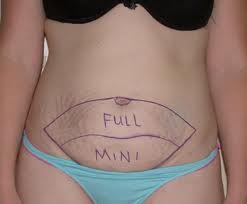The tummy tuck is the most commonly done excisional body contouring procedure. By the removal of a small (mini tummy tuck) or large (full tummy tuck) segment of skin and fat in the lower half of the abdomen, the remaining upper half of the abdominal skin is brought down over what was removed. Like the unraveling of a drop curtain, the entire abdominal surface becomes much flatter.
But in the middle of this abdominal contouring surgery sits the belly button. (umbilicus) The belly button has no functional purpose other than to serve as a reminder that we were in fact born. But even though it has no bodily function, most people do not want to be without it. I have asked many tummy tuck and abdominal panniculectomy patients if they want to lose their belly button and universally no one does. Most reply that they would not look human without it. At the least it is a source of adornment for some women.
So keeping the belly button during a tummy tuck appears to be very important. But how is to done? There are numerous perceptions about how the belly button is managed during a tummy tuck. Some say a new one is made, others say the old one is just moved. In reality, both opinions are right…and wrong.

In a mini-tummy tuck, abdominal skin is removed below the existing belly button. The stalk of the belly button is released from the muscle wall and it ‘floats’ downward with the overlying skin as it is brought down to close the lower abdominal wound. The stalk is then reattached to the abdominal wall in a lower position. This is why there is no scar around the outside of the belly button even though it actually moves lower from where it once was. Thus in a mini-tummy tuck the original stalk of the belly button and its attachment to the abdominal skin is maintained but it is moved lower.
In tummy tuck surgery, a new belly button is never made. Its attachment may be moved lower or a new hole made for it to emerge through repositioned abdominal skin. But you always keep your original belly button one way or the other.
Dr. Barry Eppley
Indianapolis, Indiana


